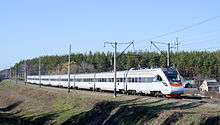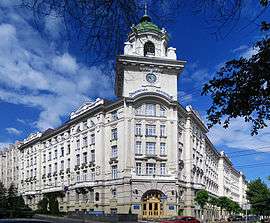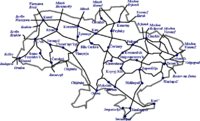Rail transport in Ukraine
| Ukraine Rail Network | |||||||
|---|---|---|---|---|---|---|---|
 | |||||||
| Operation | |||||||
| National railway | Ukrzaliznytsia (Ukr Railways) | ||||||
| Statistics | |||||||
| Ridership | 53.7 million (2014, Ukrzaliznytsia only)[1] | ||||||
| Freight | 443.222 mln tonne (2013, Ukrzaliznytsia only)[1] | ||||||
| System length | |||||||
| Total | 21,640.4 kilometres (13,446.7 mi)[1] | ||||||
| Electrified | 9,878 kilometres (6,138 mi)[1] | ||||||
| Track gauge | |||||||
| Main | 1,520 mm (4 ft 11 27⁄32 in)[1] | ||||||
| Features | |||||||
| No. stations | 1,447[1] | ||||||
| |||||||
Rail transport in Ukraine is a mode of transport by railroad in Ukraine.
General scope
It consists of several components.
- Network of railroads (and infrastructure i.e. bridges, electrification, station structures, etc)
- Rail stock operators
- Rail stock manufacturers and repair
- Variations of use
The company in charge of non-mass transit railways is Ukrainian Railways which since 2015 changed its form of ownership from state company to public.
History
Before Ukrainian Independence

Railways in Ukraine were built under the imperial rule of the Austria-Hungary (in the western territories), and later in the Russian Empire-controlled territories, having seen major development and reformation since. For more information, see:
Independent Ukraine
On 24 September 1991, following the resolution of the Verkhovna Rada (Ukraine's parliament) on separation from the Soviet Union, all railroad administration was temporarily passed to the South-Western Railways. According to the resolution, all assets located within the borders of the former Ukrainian SSR became property of Ukraine. To improve efficiency in such administration it was to create a special centralized administration. On 14 December 1991 the Cabinet of Ministers of Ukraine issued a declaration No. 356 "In creation of the State Administration of Railroad Transportation in Ukraine" which proclaimed Ukrzaliznytsia a government body in administration railroad transportation uniting the six state railroad companies.[3]
As of late 2015 the Ukrainian government is transforming the railways into a public joint-stock company named Ukrainian Railways (Ukrainian: Ukrainska Zaliznytsia).[4]
Infrastructure
The total length of railroad network is 21,640.4 kilometres (13,446.7 mi). The length of electrified railroad is 9,878 kilometres (6,138 mi). There are 1,447 train station that have 118 various station buildings. There are 2,268 various smaller stops. The infrastructure also contains 5,422 rail crossings (level crossing), 4,168 of which have automatic signaling system. At the same time 1,497 rail crossings are manned 1,468 out of those equipped with automatic signaling system (grade crossing signals).
Rolling stock
- Diesel locomotives 2,447
- Electric locomotives 1,547
- Freight railcars 111,100
- Passenger railcars 5,291
Rail stock manufacturers and repair
Manufacturers
- Luhanskteplovoz, former producer of locomotives
- Malyshev Factory, former producer of locomotives as Kharkiv Steam-locomotive Factory
- Kryukiv Railcar Works, primary producer of small locomotives and railcars
- Stakhanov Railway Car Building Works, railcar production
- DniproVahonMash (Dnieper Railcar Works), freight railcar production
Repair factories
- Darnytsia Railcar Repair
- Dnipro Railcar Repair
- Zhmerynka Railcar Repair
- Kharkiv Railcar Repair
- Konotop Railcar Repair
- Kiev Electric Railcar Repair
- Dnipro Diesel Locomotive Repair
- Poltava Diesel Locomotive Repair
- Haivoron Diesel Locomotive Repair
- Izyum Diesel Locomotive Repair
- Ivano-Frankivsk Locomotive Repair
- Lviv Locomotive Repair
- Zaporizhia Electric Locomotive Repair
Other rail transport in Ukraine
Rail transport that is used for mass transit is usually administered by local government such as city government. Such rail transport include trams, subway (metro), funicular, others.
In mountain regions a narrow gauge rail transport is sometimes privately owned.
References
- 1 2 3 4 5 6 "Statistical data on Ukrainian Railways (Статистичні дані про Українські залізниці)". Archived from the original on 2017-02-04.
- 1 2 Ukraine profile, BBC News
- ↑ "КАБІНЕТ МІНІСТРІВ УКРАЇНИ П О С Т А Н О В А від 14 грудня 1991 р. N 356". Законодавство України. 30 July 1993.
- ↑ Ukrzaliznytsia officially becomes joint-stock company, UNIAN (21 October 2015)
http://en.interfax.com.ua/news/economic/299132.html
